Solicita ahora para formar parte de nuestra próxima grupo de Becados en Ciencia científicos comunitarios y líderes comunitarios.
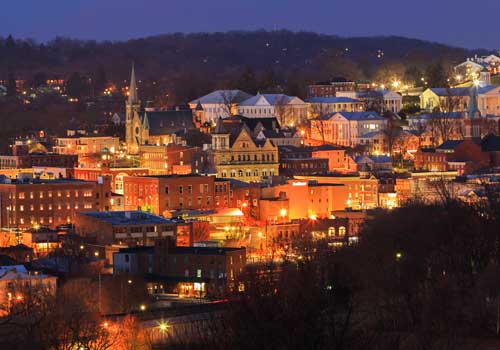
Project Title: Establishing a Plastic Waste Management Program
Location: Staunton, VA
El equipo:
Shenandoah Green wants to increase awareness about the importance of waste stream management throughout the complete flow of waste management from domestic or industrial areas to final disposal. A major community priority is to understand the leakage of waste into the environment due to poor management practices with a specific interest in impacts of single-use plastics on soil, water, and air quality is, as well as the associated human health impacts.
The Staunton, VA project was a remote collaboration between community leaders in Virginia and a scientist across the country in California. Most of their engagement was via telephone and email, but the bulk of the project work was completed during a week-long visit by Win to Staunton in September 2019 featuring 16 meetings, field sampling, and a tour of the best of Staunton’s hospitality.
The field method resources developed through this project are linked below under “Outputs and Impact.”
Meetings, Seminars, and Trainings
Shenandoah Green is an especially connective organization in the community. A priority for their week long visit was to provide Win the opportunity to meet, educate, and train their collaborators and influencers. The team’s Sunday – Friday engagements included meetings with representatives of:
Some highlights included visiting sources of local plastic pollution, learning about the local lifecycle of plastic, and discussing microplastics and community concerns with local residents. The team consistently found that those they were speaking with were excited about this work and eager to ask (Win, in particular) questions. The team is now better positioned to engage with local environmental players on plastic pollution issues, and engage them in future data collection efforts.
Sampling for Microplastics in Water
During their time together, the team conducted sampling of local waterways for microplastics in partnership with over 20 local volunteers. They did this sampling using research trawls brought in by Win from his lab, as well as a DIY home sampling kit, BabyLegs, developed by PublicLab. They rigorously compared the sampling efficiency of BabyLegs to the research grade trawl to maximize the utility of the BabyLegs trawl which will stay with Shenandoah Green. BabyLegs performed well under most of the flow conditions the team encountered, but a larger opening will be developed in the future to decrease the sampling time required when using BabyLegs.
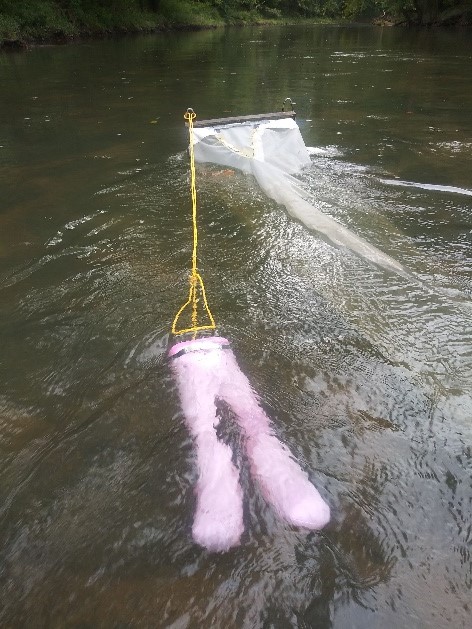
BabyLegs deployed alongside a research trawl
After 5 days of stream sampling at 6 different locations throughout the Shenandoah Valley, they found 1 piece of microplastic. This was equivalent to <1 piece of microplastic per 100 cubic meters of water. Win characterized this as well below the threshold for concern using recent plastic pollution risk assessment literature. Although no plastic is ideal.

These results allow the team to assess the health of local waterways in respect to the degree of plastic pollution. Other things were also caught in the net like leaves and insects which could be studied in future efforts to increase the knowledge that can be gained from a single sample and aid local ecology researchers. Future microplastic sampling with nets should leave the sampling device in the water to collect larger samples (> 1000 cubic meters) so that the concentrations can be accurately measured.
Sampling for Microplastics in Sediment
The team found a few locations where deposits of microplastic in sediment exist near the landfill. A future study could survey sediment throughout the streams to identify high impacted locations to monitor.
Sampling for Microplastics in Biota
A concern of Shenandoah Green is that organisms may be ingesting plastic even in though there are low concentrations of microplastics present in the streams. Future studies could also assess the impact to organisms by dissecting them and searching their gut contents for plastic.
Surveying Plastic Pollution on Land
The team surveyed Staunton streets for trash using Google Street View. 1,000 randomly distributed images were surveyed, 4/100 of which were found to contain trash. There were no clear hotspots, suggesting that trash is equally distributed throughout the city.
[ezcol_2third]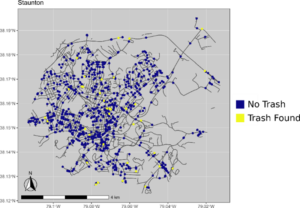 [/ezcol_2third] [ezcol_1third_end]
[/ezcol_2third] [ezcol_1third_end] [/ezcol_1third_end]
[/ezcol_1third_end]
Trash Data Analytics Tool
Prior to the visit, Win developed an online tool in consultation with Fred and Georgi to quickly analyze clean-up data for trash type and volume. This data can be used to prioritize reduction efforts through local policy and management practices. More data on trash is needed and can be collected by reaching out to people already doing cleanups and inviting them to contribute. Current results show cigarette butts and plastic pieces to be the most prevalent pieces of trash in the environment.

This project created a system of procedures and tools supporting Shenandoah Green efforts (alongside community members and other allied organizations) to document and share about the types and quantity of trash and plastic pollution in the local environment. It also fed into a larger effort by Shenandoah Green to muster community engagement on local trash and recycling priorities, and strengthen linkages between and among area nonprofit groups.
Specific outputs produced through the project include:
This collaboration also contributed to the planning and implementation of a comprehensive and strategic effort to form partnerships with key groups and individuals in and around the community. Each meeting and conversation resulted in something useful and impactful for Shenandoah Green. There were also ripple effects: influential individuals were inspired to participate in the local climate strike because of the impression the team made on them, and the Lewis Creek Watershed Committee is revisiting its charter based on conversations with the project team.
Things that contributed to the team’s success included:
Things that the team would do differently if they could start over include:
Advice the team has for future projects:
Although this Thriving Earth Exchange project is complete, Shenandoah Green is incorporating the outputs into larger community engagement work moving forward. Coming out of the project, they are equipped to train volunteers in the use of these custom procedures and tools, and can readily apply them for collecting and analyzing data from trash cleanups.
Fred and Georgi are also in the process of acquiring and deploying equipment to further monitor stream and sediment health, including sustaining collaboration with local labs to provide better understanding of impacts to the local environment from plastic pollution.
Other efforts underway, include but are not limited to:
Follow their incredible efforts at ShenandoahGreen.org.

L-R: Win, Georgi, Fred
The City of Staunton, VA and the surrounding community located in Augusta County plan to increase awareness about the importance of waste stream management, the complete flow of waste from domestic or industrial areas to final disposal. The responsiveness to environmental impacts of single-use plastics on soil, water, and air quality is a major community priority, as well as the associated human health impacts. Community leaders, including the local Earth Day committee, have outlined 4 priorities:
The City of Staunton, VA and the surrounding community located in Augusta County are the focus of this project description. Downtown Staunton is home to Mary Baldwin University. Staunton is also close to the University of Virginia, James Madison University, Washington & Lee University and Virginia Military Institute.
Staunton is consistently on many “top 20 small town” lists for culture, arts, architecture and preservation by such organizations as Smithsonian, Architectural Digest, Southern Living and several travel sites. It is a town noted for its beauty and its nationally recognized main street. Along with these recognition, the TEX community leaders would like to see Staunton appear on top lists of towns that are environmentally progressive and that practice sustainable lifestyles.
Estas actualizaciones de proyectos proceden directamente de las comunidades y los científicos con los que trabajamos. Envíe a su enlace de Thriving Earth una actualización rápida y una foto, ¡y destacaremos su proyecto en nuestro próximo boletín!
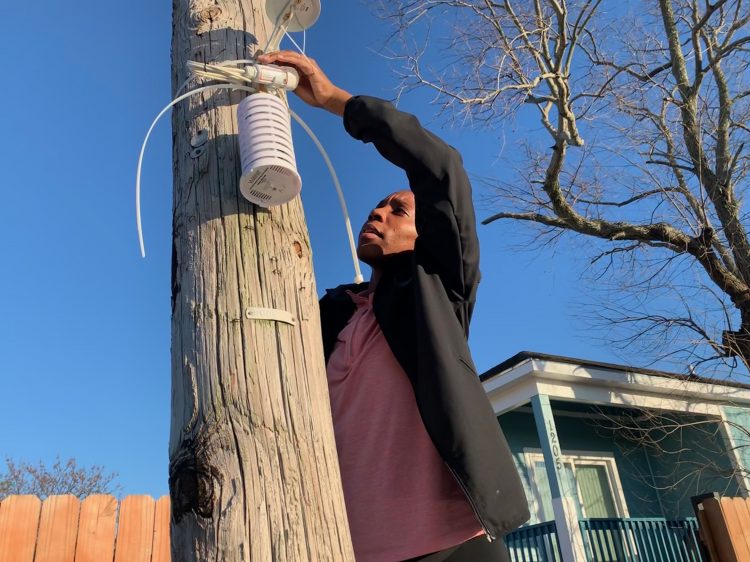
Yasmin Davis instala sensores meteorológicos
Desde 7th Ward , Nueva Orleans: Sensores, dinero y árboles en el 7th Ward: Yasmin Davis (en la foto) y Kayla Frand instalaron sensores para captar las características meteorológicas locales con ISeeChange. El equipo recibió una subvención de 3.825 dólares del Centro de Servicios Públicos de Tulane para reuniones comunitarias, asistencia estudiantil y más sensores. En colaboración con Thriving Earth Exchange, Tulane, Georgia Tech y la EPA, se crearon imágenes de plantaciones de árboles photoshopeadas para recabar las opiniones de la comunidad en el 7th Ward, bajo la dirección de la líder comunitaria Angela Chalk.
Desde Durango, Co: Durante 2018 y principios de 2019, la Coordinadora de Sostenibilidad de la Ciudad de Durango, Imogen Ainsworth, trabajó con científicos locales, Laurie Williams y Joanna Gordon Casey, para llevar a cabo un Inventario de Emisiones de Gases de Efecto Invernadero en toda la Comunidad para el área dentro de los Límites de la Ciudad de Durango.
En marzo de 2019, tras mucha colaboración, aprendizaje y algunos retos, Imogen presentó un borrador de datos al Ayuntamiento de Durango. A excepción de los datos del transporte por carretera, las cifras presentadas serán probablemente las que aparezcan en el informe final. El borrador del inventario revela que el uso de energía por parte de edificios e instalaciones comerciales es la mayor fuente de emisiones, seguida del transporte y la energía residencial.
Imogen trabaja actualmente en la elaboración de un proyecto de informe sobre el inventario, en el que se destacan los resultados, las medidas adoptadas para reducir las emisiones y las posibles acciones futuras. El informe será revisado en primer lugar por el personal de la ciudad junto con Laurie y Joanna, antes de ser compartido con otros miembros de la comunidad y, por último, publicado en el sitio web de la ciudad y compartido con el público.
De acuerdo con el Plan de Acción para la Sostenibilidad de la Ciudad, el inventario se actualizará cada tres años, y la próxima actualización se realizará en 2020 con los datos de 2019. Una vez finalizado el informe del inventario, el equipo trabajará para documentar la metodología e identificar oportunidades de mejora en los procesos de recopilación de datos y elaboración de informes.
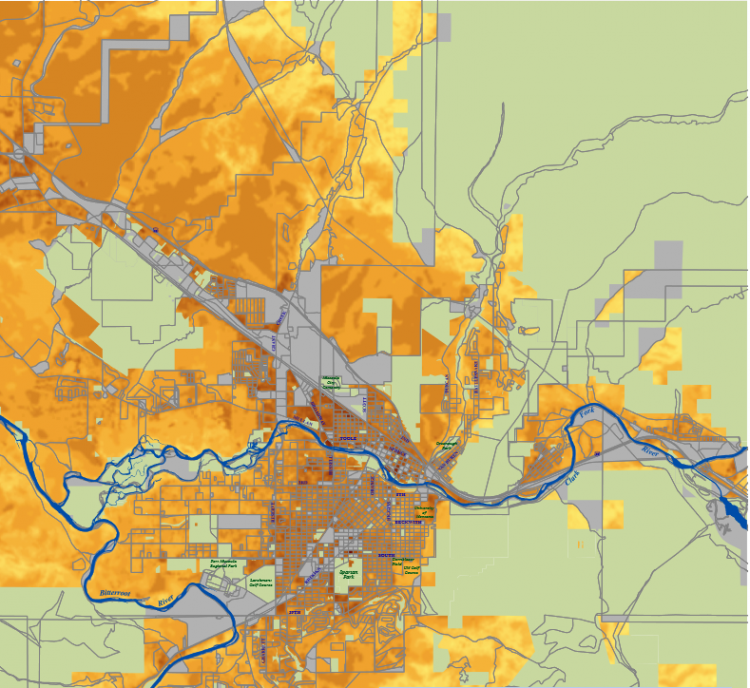
Mapa de vulnerabilidad a la temperatura creado por Julia Tomkins M.S. Montana University
Desde Missoula, Mont.: Una investigación estudiantil muestra que el aumento del calor y los incendios forestales pondrán en peligro a los discapacitados de Missoula. Climate Smart Missoula y la Oficina del Clima de la ciudad de Missoula iniciaron este proyecto con Thriving Earth Exchange para estudiar los efectos del calor en el entorno urbano de Missoula. El mapa de vulnerabilidad al calor superpuso los factores socioeconómicos con la exposición al calor para la ciudad de Missoula a escala de bloques censales sin precedentes. Los principales componentes de la vulnerabilidad están fuertemente vinculados a las comunidades con discapacidades, que viven solas o con bajos ingresos. Estos resultados se presentarán a los comités de la ciudad de Missoula y al pleno del Consejo, y el equipo tiene previsto presentarlos en una sesión del Plan Maestro del centro de Missoula y en una reunión de Invest Health.
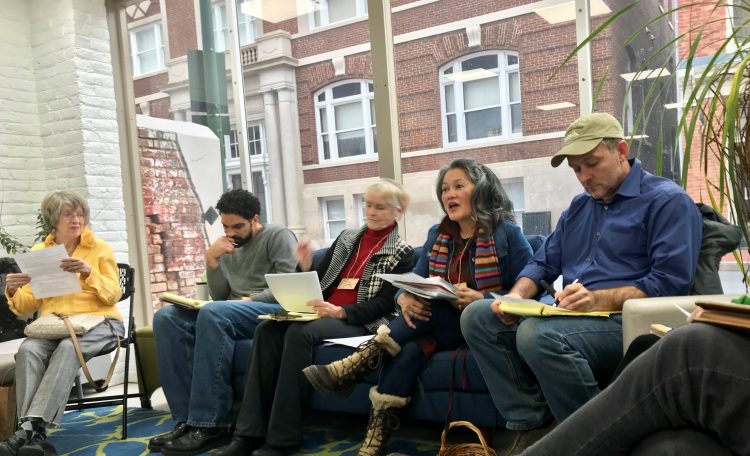
BJ Vaughn en representación de Staunton Downtown Development Association, Melody Tennant, Presidenta de Shenandoah Green, Georgi Tomisato, Fundador-Presidente de Shenandoah Green y Tim Kreps en representación de Sustainable Shenandoah Valley.
Desde Staunton, Va.: ¡La colaboración es clave! El objetivo de este proyecto es eliminar las pajitas y bolsas de plástico de un solo uso, cartografiar y reducir el flujo de residuos de Staunton, medir el plástico en el río Middle y sus afluentes (todos ellos forman parte de la cuenca de la bahía de Chesapeake) y educar al público sobre los peligros del plástico. En enero, los dos líderes comunitarios del proyecto unieron fuerzas con otras personas de la comunidad interesadas en la lucha contra el plástico y formaron un grupo llamado Shenandoah Green. Shenandoah Green tuvo su primera reunión de múltiples grupos comunitarios y la alcaldesa local, Carolyn Dull, el 01 de febrero de 2019 para discutir los recursos y la colaboración necesaria para desarrollar una iniciativa de conservación sostenible en el valle de Shenandoah.
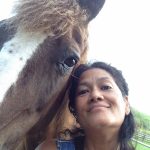 Georgi Tomisato of EarthDay Staunton is a farm owner in Augusta county and active member of the City of Staunton. She is a former educator, practicing farmer and community activist.
Georgi Tomisato of EarthDay Staunton is a farm owner in Augusta county and active member of the City of Staunton. She is a former educator, practicing farmer and community activist.
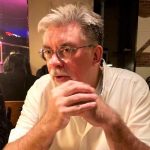
Fred Blanton, an involved resident of the City of Staunton, is an analyst with Boeing and a Sister Cities International Representative.
Georgi and Fred are founding members of Shenandoah Green, a non-partisan, grass-roots organization, working with local and scientific stakeholders to create an environmentally sustainable community through education and advocacy.
Win Cowger, University of California, Riverside (Photo and biography coming soon!)

RiverPickers Carol, David, Joe, Mark, Marion
The Friends of the Middle River (FOMR) was started in 2010 by a group of citizens who had been influenced and inspired by a conference in 2009, sponsored by the Virginia Department of Environmental Quality (DEQ). The organizers of FOMR felt that the community of residents who were interested in the welfare of the Middle River needed a collective voice. Since 2010, FOMR has sponsored activities to heighten awareness of the Middle River’s recreation opportunities as well as its water quality challenges.
Our mission: FOMR promotes the stewardship and enjoyment of the Middle River Watershed through volunteer action, education, science, and outreach.
(c) 2024 Thriving Earth Exchange